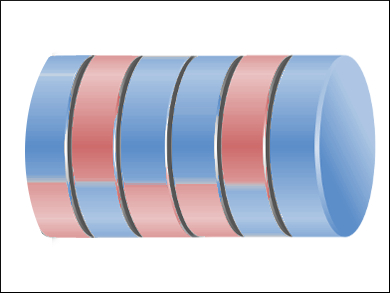Janus particles, whose opposing faces have different chemical properties, can stabilize emulsions, serve as catalysts and nanomotors, and provide binary capabilities in optical applications. Recently, Janus films have been fabricated, but making Janus cylinders has proven to be more difficult.
Olivier Colombani, LUNAM Université, Université du Maine, Le Mans, France, and colleagues have been functionalizing urea compounds with polymeric side chains to form self-assembled “bottle brush” structures with hydrogen-bonded urea cores. They predicted that this could be a simple method of making Janus cylinders. To test their prediction, they used two incompatible polymers, polystyrene and poly(isobutylene), for the side chains. They prepared their molecular assemblies in cyclohexane at 20 °C.
This method produced “patchy” bottle brushes, which contain partially segregated polystyrene and poly(isobutylene) regions. The researchers predict that increasing the length of the polymer arms or using more strongly incompatible polymers could increase the degree of segregation and produce a true Janus cylinder with two distinct sides.
- Patchy Supramolecular Bottle-Brushes Formed by Solution Self-Assembly of Bis(urea)s and Tris(urea)s Decorated by Two Incompatible Polymer Arms,
Sylvain Catrouillet, Laurent Bouteiller, Olivier Boyron, Cédric Lorthioir, Erwan Nicol, Sandrine Pensec, Olivier Colombani,
Langmuir 2016.
DOI: 10.1021/acs.langmuir.6b01609
Also of Interest
- The Two Faces of Janus Films,
Nancy McGuire,
ChemistryViews.org 2016.
Nanofilms with one hydrophobic side and one hydrophilic side stay strong, even in salt solutions




